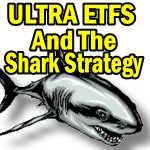The Shark Option Trading Strategy done properly can result in excellent gains with limited capital exposure. The Shark Option Trading Strategy is available through my shop in PDF format. Anyone interested can access it through this link.
This article came about after receiving an email from an investor who has been paper trading with the Shark Strategy and had some questions. As I started to answer his questions I realized that there was quite a bit more information needed to properly assist with his questions. This article is a result of his questions. Whether as an investor you are interested in trading options or not, I think will find the information about Ultra ETFs of value in both understanding them and contemplating a use for them in a portfolio. Let’s start with the Reader’s questions.
Reader’s Questions On The Shark Strategy
Here is the recent email from an investor.
I just reread (and have been paper trading) the Shark Strategy. I like to do short trades…less than a week. I like leveraged underlyings with weeklies like AGQ. that way, if I get into trouble I don’t have to hold for a month at a time.
Here’s my question (in 2 parts):
1) Is the Shark the best strategy for these preferences?
2) Are there other underlyings that would be comparable or even preferable to AGQ?
Thanks – Sam
Why The Shark Strategy Was Developed
To answers Sam’s questions we should understand why the Shark Strategy was developed.
Trading Options can often result in returns better than 50% in a trade and often within a few days. I developed the Shark Strategy because I wanted a better timing system to get a signal when to enter a trade and a signal when to exit one. I wasn’t looking for an automated system, but certainly a system that reduced risk of capital loss which would then mean I could put more capital to work. I know that often an option can be bought for .50 cents and a day or two later it can be worth $1.00. While this is a spectacular return, I found that if I could only place a few thousand dollars at risk in such a trade, then the return while excellent, was still a lot of work for a possibly $500 to $1500 gain. However if I could put together a timing system that pinpointed when to enter and exit a trade I knew I could then apply $20,000 or $30,000 to a trade and earn $10,000 to $15,000 in very short order. This to me would make the work involved in trading options worthwhile.
To help generate such large returns I turned to the Ultra ETFs like AGQ. These Ultra Type ETFs that provide 2X and 3X the return of the underlying index or asset have the leverage and volatility to provide spectacular returns with option trading. I therefore developed the Shark Option Trading strategy for use on these Ultra ETFs.
I also developed the Shark strategy for use against Ultra ETFs to combat two problems that are common with trading Ultra ETFs.
Problems With ULTRA ETFs
1 – Leverage Creates Slippage
The biggest problem with Ultra ETFs is slippage. Investors believe that these leveraged Ultra ETFs will provide two and three times the return of the underlying indexes. Therefore many investors feel that if, for example, the S&P 500 were to gain 12% in a year, a 2 X Ultra ETF would provide a 24% return and a 3 X Ultra ETF would provide a 36% return. This is not the case due to the daily movements of the indexes themselves. Instead of ending up with a 36% gain an investor might wind up with a gain of only 10% because the longer they are in these Ultra ETFs, the more slippage there is in the price of the ETF itself due to the highly leveraged nature of these ETFs.
For example, if an index were to jump higher on a Wednesday by 5% and then collapse on a Thursday by 5%, investors in Ultra ETFs would expect an almost neutral position wherein the loss could be as high as 4%, due to the highly leverage nature of these Ultra type ETFs. Investors would do well to read the prospectus to understand Ultra ETFs before entering them. To understand better let’s take a look at how some leveraged Ultra ETFs performed in the bear market in 2008.
NASDAQ Index Decline 2008
In 2008 the NASDAQ Index fell 781 points for a 38% loss from October 3 2008 to March 9 2009.
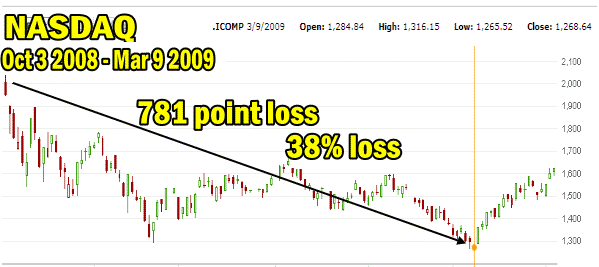
The NASDAQ decline from October 3 2008 to March 9 2009
QLD ETF 2008 Bear Market
The QLD ULTRA ETF provides a 2X return of any rise in the NASDAQ 100 Index. Therefore any person who bought this index on October 3 would have realized a loss of 60% by March 9 2009. So while the NASDAQ lost 38%, the QLD ETF did not lose 72%, but instead lost 60% of its value.
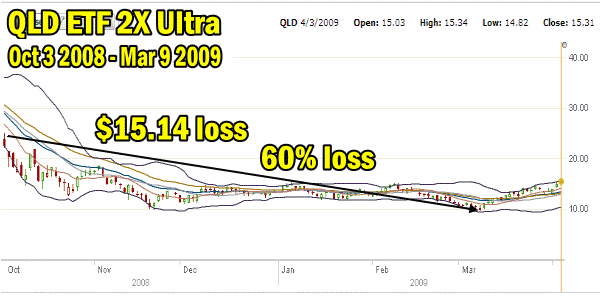
QLD ETF from Oct 3 2008 to March 9 2009
QID ETF 2 X Ultra Short
The QID ETF provides a 2X Ultra Short return of the NASDAQ 100 Index. Over the same period that the NASDAQ index lost 38% and the QLD lost 60% the QID if held throughout this period only gained 12%. This is because the constant movement up and down within the NASDAQ index is constantly being reflected in the daily price of the Ultra Short ETF. You can see in the chart that there were significant periods when selling would have yielded excellent returns, but if held throughout this period the return would have been only 12%. This is the problem with highly leveraged funds.
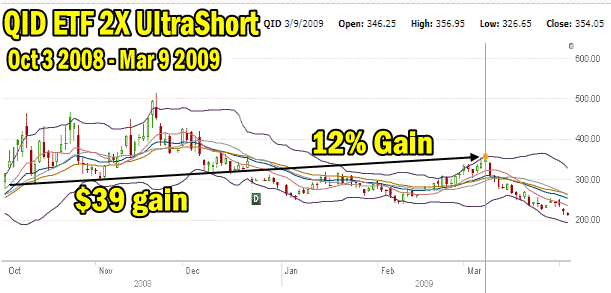
QID ETF 2X Ultra Short From October 3 2008 to March 9 2009
2 – Timing Entry and Exit
The other problem with these highly leveraged ETFs is timing entry and exit positions. You can see from the above two Ultra ETFs that knowing when to buy and when to sell impacts the returns. There is also a lot of evidence to show that buying highly leveraged funds near a market top if you are bullish or a market bottom is you are bearish can provide shocking losses.
For example in October 2008, Warren Buffettt discussed how he was buying stocks. An investor who believed that by October 3 the collapse of stocks in the NASDAQ was already overdone, might have bought the QLD ETF to profit handsomely from a rebound or a bounce back of stocks. However this did not happen and instead stocks collapsed another 38%. Anyone who bought the QLD would have suffered huge losses.
Meanwhile on October 3 other investors who felt that the NASDAQ had much further to fall might have bought the QID Ultra Short. As the market did in fact collapse further, you can see in the QID chart that the best time to have sold out for large gains was in late November. Yet from late November until march 3 2009 the NASDAQ continued to plunge. The problem though was that there were also some incredible bounce backs which due to the highly leveraged nature of these ultra funds meant that the expected returns would never be realized. So an investor who held until March 3 actually only earned 12%. An investor who held beyond March 3 would have eventually actually lost capital. Shocking to say the least when you consider the devastation of this severe bear market.
Therefore these highly leveraged funds are not meant to be held but are meant for short-term trading at best.
Enter The Shark Option Trading Strategy
The Shark Strategy though is meant for those investors who want to trade continuously within these highly leveraged funds. Part of the success of the Shark Strategy is because it does not matter which way the Ultra ETF is moving. The Shark strategy pinpoints when to buy and when to sell options. Due to the highly leveraged nature of the Ultra ETF options bought can quickly jump 50% or more in value. This is what the Shark Strategy relies upon and it works to get the investor out before the profits are lost in any bounce back whether it is a bounce lower or higher.
Weekly Options Are Not Needed
So to answer part of Sam’s question, the weekly options are not needed. The whole concept of the Shark Strategy is to let the strategy pinpoint entry and exit time periods. Often a trade may last only a day or two. Therefore even if you are trading within an Ultra ETF that has only monthly options available, you may be in and out of the trade half a dozen times or more in a month. The Shark Strategy doesn’t rely on using weekly options but is looking at the moment to buy puts or calls and then when to sell them. Some trades then could last a few weeks such as my Apple Stock trades did in 2012 as the stock was running higher and then as the stock collapsed. If I had used the Shark Strategy for the Apple Stock weekly options, I would have earned considerably less because my options would have continually expired each week OR would have needed me to keep rolling the options which would have meant I would have continually be laying out more premium to buy options one week out as the stock kept rising and when it was falling. You can understand this better if you read this article which looks at the Apple Stock trades from 2012 using the Shark Strategy. You can see that often weeks passed before a trade was closed.
Using A Stop-Loss
Perhaps then for Sam if he wants to use the Shark Strategy for weekly options only, it could be modified somewhat by using a stop-loss once the trade is entered. Therefore the Fast Stochastic and Moving Averages would be used only to time entry into a trade and then a stop-loss could be set up based on the degree of risk Sam was willing to take. The more risk Sam was willing to take to try to earn more from the trade, the wider the stop-loss. The less risk, the tighter the stop-loss. Using a stop-loss might let an investor do more trades weekly than using just the Fast Stochastic and Moving Averages to time exiting the trade as well as entering it. However by concentrating on the weeklies only, there may be weeks when there are no entry signals because the trade when entered was still not being signaled by the Shark to be exited. Therefore if Sam exits a trade within a week because of using the weeklies, he may find that the original trade actually was meant to be held into a second or even third week. The weekly got him out of the trade, but Sam may end up with smaller profits because it is the purpose of the Shark Strategy itself to time getting in and when to get out.
Therefore in my opinion if Sam wanted to concentrate solely on weekly options only, I would suggest that the Shark Strategy is not the best strategy to use for weekly option trading.
Best Strategy For Ultra ETFs
As FullyInformed Members know from the market direction portfolio, these highly leverages ETFs can also be used for swing trading. The market direction portfolio which you can access here if you are a FullyInformed Member, is being managed by Doug Harris and he buys and sells shares of 3 X ETFs against the DOW Index, but does not do any options. Right now for example he is holding shares in the UDOW, a 3X Ultra Pro ETF which provides 3 X the daily return of the DOW.
But while these leveraged ETFs can be traded I think there are 5 reasons why the Shark is superior to trading shares of highly leveraged ETFs.
1) Small amounts of capital required for The Shark Option Trading Strategy. Doug Harris is using approximately $300,000 of capital and is aiming for a 25% annual or better return. The Shark Strategy uses a lot less capital but can generate much higher returns against the amount of capital being used.
2) No need to commit capital to shares.
3) Rarely caught at the top of a rally and rarely caught in a plunge. The Shark strategy times when to get in and out. It is rare when a signal is given at a market top simply because the technical timing tools need more time period than a day or two to signal entry and exit positions. This means that when a market top is reached, it is rare for the signals to be generated because more time is needed at a market top. It is rare when a market top lasts more than a few days at best.
4) No concern as to what direction the security is headed. In other words you are trading within the same ETF up, down or sideways. With shares, you would want to work with two ETFs, one of them an Ultra pro that rises with the rise in the index and an Ultra Short that falls when the index falls. This is unnecessary with the Shark Option Trading Strategy. You simply buy and sell puts or calls depending on the market direction.
5) Rarely get caught missing a rally or a tumble in the stock. This is a good example again as the sideways action of the market has, for example, kept Doug Harris on the sidelines for a little over a week since the sideways movement can damage his Market Direction Portfolio if not traded properly. There is no such problem with the options as the Shark Strategy timing signals are followed whether the stock is moving sideways, up or down.
Other Strategies With Ultra ETFs
I think Sam should also understand that other strategies can be successful when trading Ultra ETFs. These include credit spreads, straddles, strangles, butterflies, iron condors and even Put Selling of both calls and puts. Overall though my experience has been that the Shark Strategy returns are much higher and the signals much easier to follow, minimizing risk to capital and maximizing the profit potential.
So the answer to question 1 is a partial yes. I believe the Shark Strategy is best for highly leveraged ETFs like AGQ, but if the interest is primarily limited to only doing the weekly options I would suggest not using the Shark Strategy.
Other ETFs or Stocks For The Shark Strategy
1 – ETFS
Sam’s second question was concerned with finding other highly leveraged products for using the Shark Strategy against.
AGQ ETF is ideal since it follows silver and is a 2X ultra fund. Silver tends to be highly volatile which is why the Shark excels with AGQ.
However the Shark strategy works well with any reasonably volatile assets but there needs to be highly liquid options available. This is because if an ETF has low volume, it is easy for the market maker to manipulate the option premiums since in all probability the market maker is the principal investor involved. UDOW is a good example.
Below are the one month out options traded on Feb 19. With the UDOW closing at $67.55, only 10 contracts changed hands at 65 and look at the spreads between bid and ask. The Shark strategy cannot work in this type of Ultra ETF. There are also no weekly options available, just monthly.

UDOW Options for March 2013
One of the more popular Ultra ETFS is the SDS Ultra Short 2X ETF. Below are the options for the SDS which closed at $46.61 on Feb 19 2013. There is enough volume and the spreads are close enough that this Ultra ETF will work with the Shark Strategy. But there are no weekly options available for the SDS.
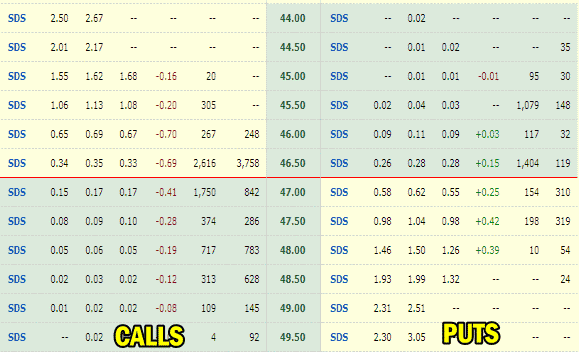
SDS Options For March 2013
One ETF that is not an Ultra ETF that I have used the Shark Strategy against is the SPY ETF. The SPY ETF is not a 2X or 3X Ultra ETF, but it has extremely liquid options that are difficult for manipulation. The Spy Put Options trade in .$1.00 increments until the prevailing week. When the pervailing week arrives the near the money options trade in .50 cent increments. When I use the Shark Strategy I am always 1 to 2 months out in time so I do not trade the .50 cent increments. Below are the Feb 22 options with the SPY ETF closing at $153.25 on Feb 19 2013. You can see that volumes are excellent and because this is the prevailing expiry week, there are .50 cents increments available.
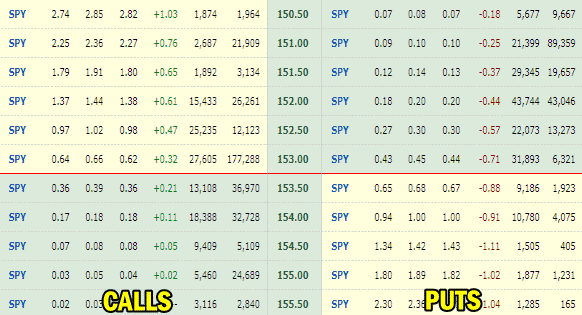
SPY ETF Options for March 2013
I cannot tell you which Ultra ETFs are best as I do not trade in a lot of Ultra ETFs. However you need to seek out those with high volumes such as the Powershares QQQ ETF, and those that trade with tight bids and asks ranges. Last, you want an Ultra ETF where the options trade in .50 cents increments when possible. These are what will make the Shark Strategy work well in an Ultra ETF.
Stocks For The Shark
Among Stocks, you should seek out those that are high in volatility. In 2012 I used the Shark Strategy against Apple Stock. The returns were terrific as the stock climbed to a high of 700 and then collapsed rapidly back down. The Shark strategy gave very clear signals both up and down for Apple Stock in 2012.
When dealing with stocks, the Shark Strategy does not need all the same parameters as the Ultra ETFs. Below are the Apple Stock March 16 options as of Feb 9 2013 at the close. You can see that volumes are good which is a required element but the strikes in $5.00 increments which still is perfect for this stock since it tends to trade in a wide daily range.
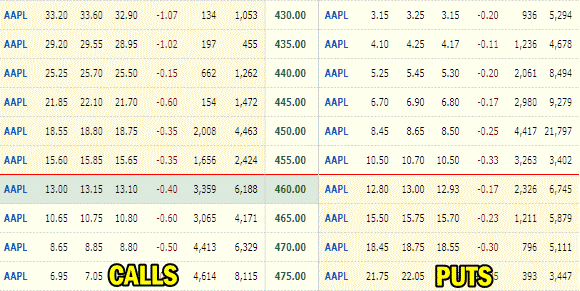
Apple Stock March 16 Options Expiry
Other stocks would include Google Stock and Priceline Stock. You need stocks with high volatility and plenty of movement in the underlying stock. Overall though Ultra ETFs fit the Shark Strategy well.
Shark Strategy Questions Summary
I do not believe there are other ETFs that are preferable to AGQ. It will vary throughout the years as to which Ultra ETFs are the best to trade within. As to stocks I have used the strategy on various stocks over the years but almost always on stocks that are volatile. It is high volatility that drives the Shark strategy to profits. In periods of higher volatility such as market corrections and bear markets, the Shark Strategy performs even better with more signals and more trades.
I hope this answers Sam’s questions but if the main interest lies with the weekly options only I would suggest considering other strategies instead. The Shark Strategy paper is part of the 4 Investment Strategies for Ultra ETFs portfolio. For interested investors the strategy paper can be reviewed and purchased through this link.

